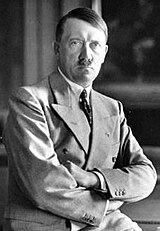
Back Парламенцкія выбары і рэферэндум у Германіі (1936) Byelorussian Eleccions i referèndum d'Alemanya del 1936 Catalan Německé volby do říšského sněmu 1936 Czech Valget og folkeafstemning i Tyskland 1936 Danish Reichstagswahl 1936 German Elecciones y referéndum de Alemania de 1936 Spanish انتخابات و همهپرسی آلمان، ۱۹۳۶ Persian Élections législatives allemandes de 1936 French Pemilihan umum dan referendum Jerman 1936 ID Elezioni parlamentari in Germania del 1936 Italian
| |||||||||||||||||||||||||||||||
All 741 seats in the Reichstag 371 seats needed for a majority | |||||||||||||||||||||||||||||||
|---|---|---|---|---|---|---|---|---|---|---|---|---|---|---|---|---|---|---|---|---|---|---|---|---|---|---|---|---|---|---|---|
| Registered | 45,455,217 ( | ||||||||||||||||||||||||||||||
| Turnout | 99.0% ( | ||||||||||||||||||||||||||||||
| |||||||||||||||||||||||||||||||
| |||||||||||||||||||||||||||||||
Parliamentary elections were held in Germany on 29 March 1936.[1] They took the form of a single-question referendum, asking voters whether they approved of the military occupation of the Rhineland and a single party list for the new Reichstag composed exclusively of Nazis and nominally independent 'guests' of the party. Like previous votes in the Nazi era, it was rigged,[2] with a claimed turnout of 99% and 98.8% voting in favour. In a publicity stunt, a number of voters were packed aboard the airships Graf Zeppelin and Hindenburg, which flew above the Rhineland as those aboard cast their ballots.[3]
This was the first German election held after enactment of the 1935 Nuremberg Laws, which had removed citizenship rights (including the right to vote) from Jews and other ethnic minorities. In the previous elections and referendums under Nazi rule, Jews, Poles and other ethnic minorities had been allowed to vote without much interference, and even tacitly encouraged to vote against the Nazis (especially in districts that were known to have large populations of ethnic minorities). On 7 March 1936, Jews and Romani lost their right to vote.[4] Their removal from the electoral process accounted for much of the large drop in invalid and negative votes,[citation needed] which fell from over five million in 1934 to barely half a million in 1936. The Nazis also lowered the voting age, in large part so as to ensure that the electorate was about the same size as in 1934 but also to exploit the relatively enthusiastic support of younger Germans for the Nazi regime.

- ^ Nohlen, Dieter; Stöver, Philip (2010). Elections in Europe: A data handbook. Nomos. p. 762. ISBN 978-3-8329-5609-7.
- ^ Richard J. Evans (26 July 2012). The Third Reich in Power, 1933 - 1939: How the Nazis Won Over the Hearts and Minds of a Nation. Penguin Books Limited. p. 637. ISBN 978-0-7181-9681-3.
- ^ "Germans for Hitler 99 Per Cent Strong: All Ballots Against Nazi Held Invalid". Fairbanks Daily News-Miner. Associated Press. 30 March 1936. p. 1.
- ^ Robert Gellately; Nathan Stoltzfus (27 May 2001). Social Outsiders in Nazi Germany. Princeton University Press. p. 216. ISBN 0-691-08684-2.
Cite error: There are <ref group=lower-alpha> tags or {{efn}} templates on this page, but the references will not show without a {{reflist|group=lower-alpha}} template or {{notelist}} template (see the help page).
